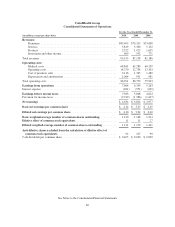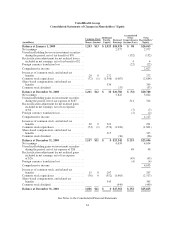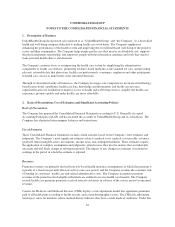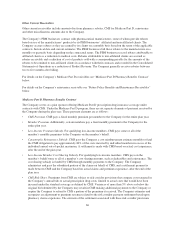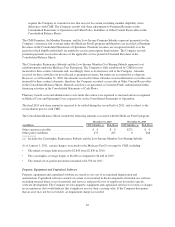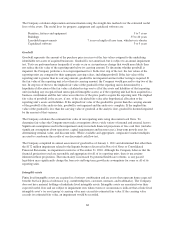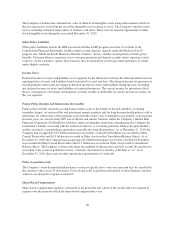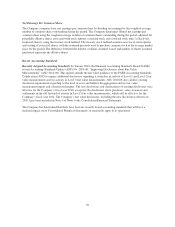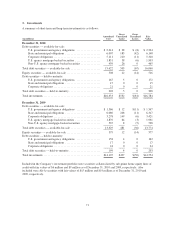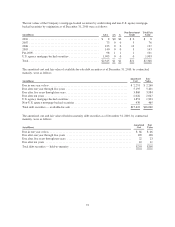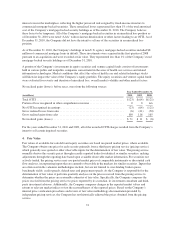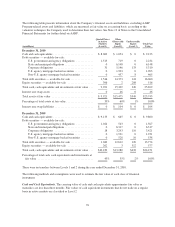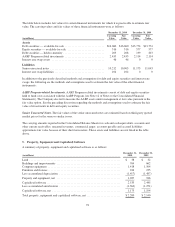United Healthcare 2010 Annual Report Download - page 70
Download and view the complete annual report
Please find page 70 of the 2010 United Healthcare annual report below. You can navigate through the pages in the report by either clicking on the pages listed below, or by using the keyword search tool below to find specific information within the annual report.The Company calculates depreciation and amortization using the straight-line method over the estimated useful
lives of the assets. The useful lives for property, equipment and capitalized software are:
Furniture, fixtures and equipment 3 to 7 years
Buildings 35 to 40 years
Leasehold improvements 7 years or length of lease term, whichever is shorter
Capitalized software 3 to 5 years
Goodwill
Goodwill represents the amount of the purchase price in excess of the fair values assigned to the underlying
identifiable net assets of acquired businesses. Goodwill is not amortized, but is subject to an annual impairment
test. Tests are performed more frequently if events occur or circumstances change that would more likely than
not reduce the fair value of the reporting unit below its carrying amount. To determine whether goodwill is
impaired, the Company performs a two-step impairment test. In the first step of the test, the fair values of the
reporting units are compared to their aggregate carrying values, including goodwill. If the fair value of the
reporting unit is greater than its carrying amount, goodwill is not impaired and no further testing is required. If
the fair value of the reporting unit is less than its carrying amount, the Company would proceed to step two of the
test. In step two of the test, the implied fair value of the goodwill of the reporting unit is determined by a
hypothetical allocation of the fair value calculated in step one to all of the assets and liabilities of that reporting
unit (including any recognized and unrecognized intangible assets) as if the reporting unit had been acquired in a
business combination and the fair value was reflective of the price paid to acquire the reporting unit. The implied
fair value of goodwill is the excess, if any, of the calculated fair value after hypothetical allocation to the
reporting unit’s assets and liabilities. If the implied fair value of the goodwill is greater than the carrying amount
of the goodwill at the analysis date, goodwill is not impaired and the analysis is complete. If the implied fair
value of the goodwill is less than the carrying value of goodwill at the analysis date, goodwill is deemed impaired
by the amount of that variance.
The Company calculates the estimated fair value of our reporting units using discounted cash flows. To
determine fair values the Company must make assumptions about a wide variety of internal and external factors.
Significant assumptions used in the impairment analysis include financial projections of free cash flow (includes
significant assumptions about operations, capital requirements and income taxes), long-term growth rates for
determining terminal value, and discount rates. Where available and appropriate, comparative market multiples
are used to corroborate the results of our discounted cash flow test.
The Company completed its annual assessment of goodwill as of January 1, 2011 and determined that other than
the $172 million impairment related to the Ingenix business discussed in Note 6 of Notes to Consolidated
Financial Statements, no impairment existed as of December 31, 2010. Although the Company believes that the
financial projections used are reasonable and appropriate for all of its reporting units, there is uncertainty
inherent in those projections. That uncertainty is increased by potential health care reforms, as any passed
legislation may significantly change the forecasts and long-term growth rate assumptions for some or all of its
reporting units.
Intangible assets
Finite lived intangible assets are acquired in a business combination and are assets that represent future expected
benefits but lack physical substance (e.g., membership lists, customer contracts, and trademarks). The Company
does not have material holdings of indefinite lived intangible assets. Intangible assets are amortized over their
expected useful lives and are subject to impairment tests when events or circumstances indicate that a finite lived
intangible asset’s (or asset group’s) carrying value may exceed its estimated fair value. If the carrying value
exceeds its estimated fair value, an impairment would be recorded.
68




